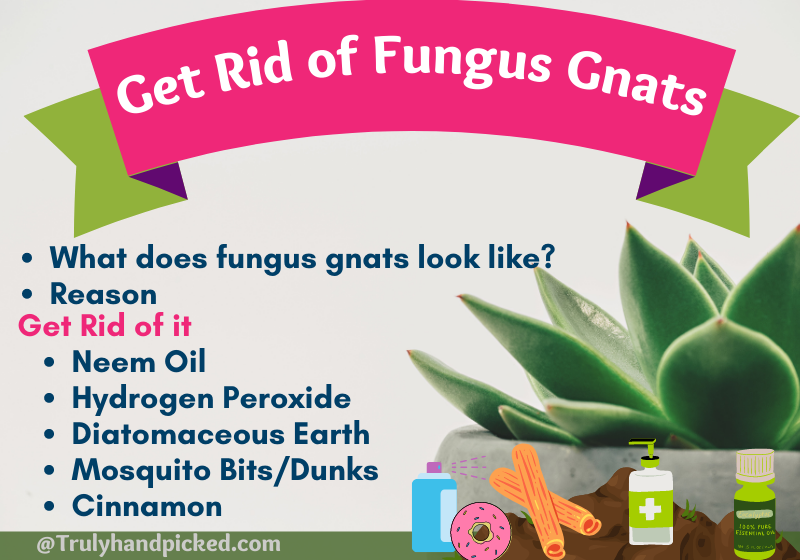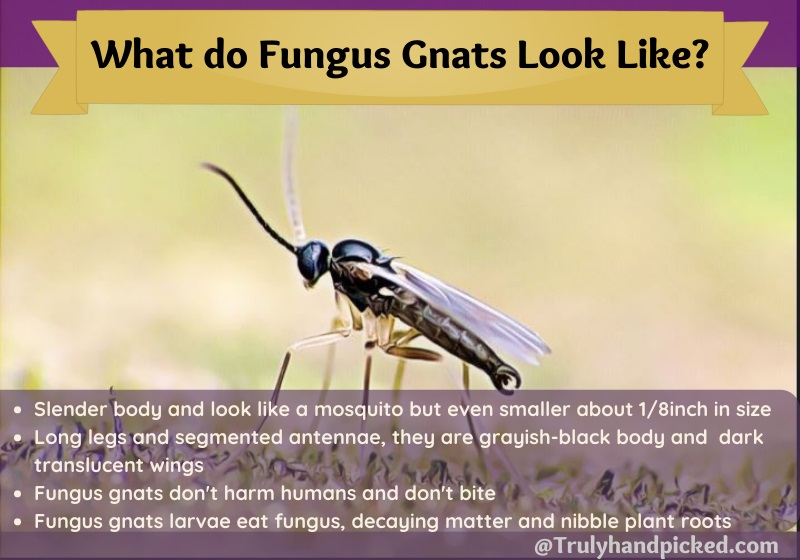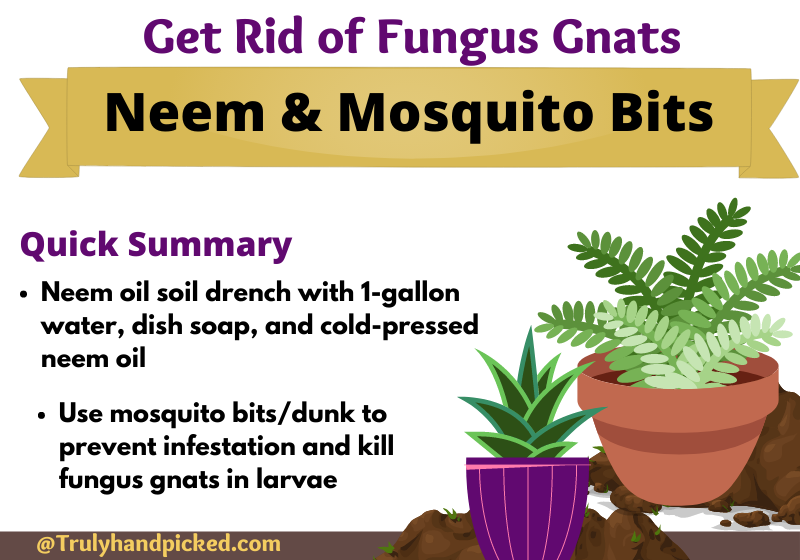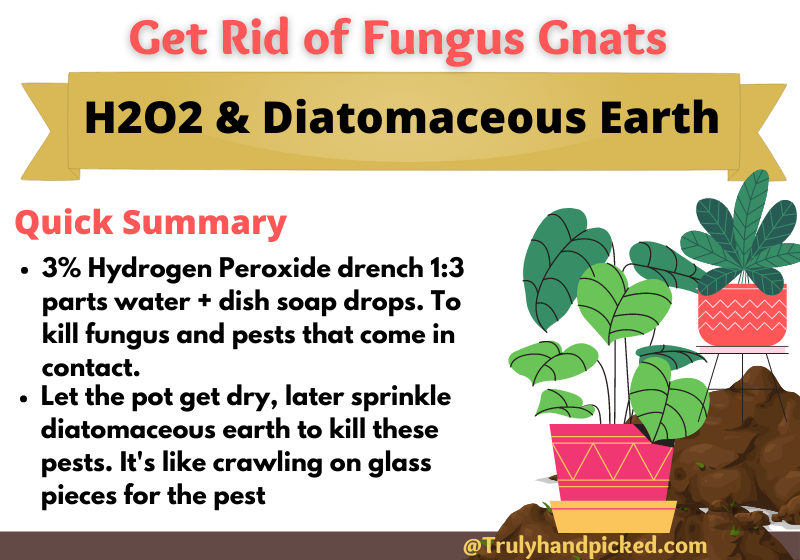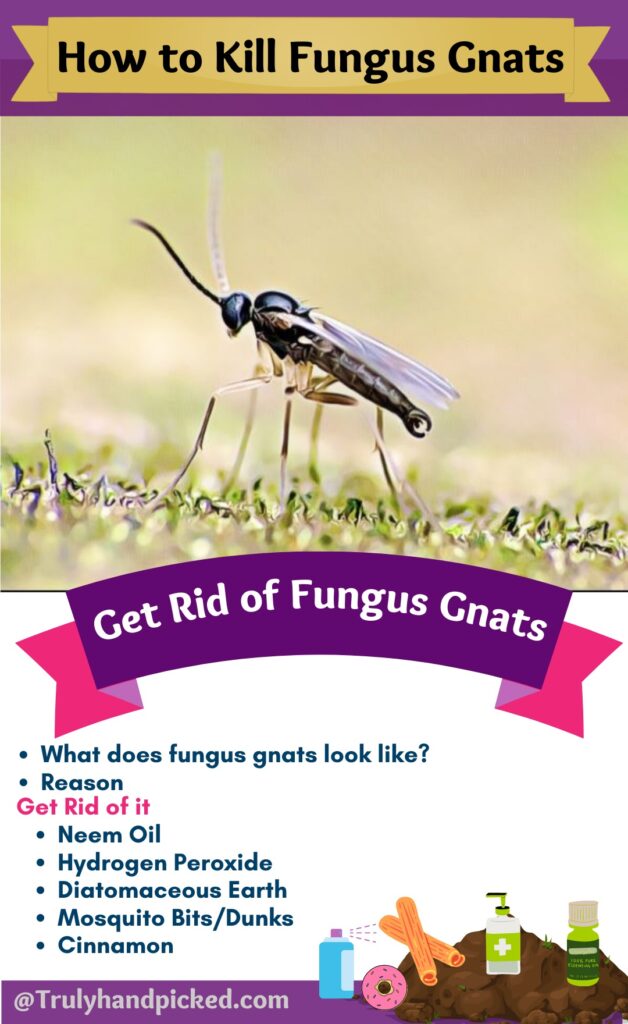Fungus gnats are extremely annoying and one of the most exasperating plant pests to deal with. Once your houseplants get infected with these insects, it will destroy your plants and mental peace singlehandedly! All you need to do is that get rid of those frustrating bugs as soon as possible from your garden area.
You may come across plenty of pesticide options, which are either harmful or too expensive to purchase. Hopefully, we have some natural alternatives in hand, which can aid you to revolve these plant pests efficiently.
Actually, it’s not the adult fungus gnats that are visible to your eyes that create the problem, it’s the hungry larvae that while foraging fungi eat up the food and plant roots.
To get rid of fungus gnats use neem oil drench, neem cakes, diatomaceous earth, mosquito bits/dunks, cinnamon and hydrogen peroxide drench to kill gnats.
Also, don’t overwater to avoid root rot which turns into fungus gnats’ food source, and use yellow sticky fly traps to prevent fungus gnats.
What are Fungus Gnats?
Fungus gnats are one type of tiny fly, whose larva feeds mainly upon fungi. They belong to the Sciaroidea family and are considered as a very short-lived gnat among their other species. In a life cycle they hatch from eggs, they form in larvae then turn into pupate, and finally, mature flying adults, and all this happens in just 3 weeks’ time. While this can speed up if the temperature and environment is in favor of these pests
Once they infect your plants, the female ones of the clan will release hundreds of small eggs on the moist surface of the soil. These larvae feed on fungi as well as decay matter, and at the same time, they devour the roots of your houseplants badly.
What do Fungus Gnats Look Like?
They have a slender body and look like a mosquito but are very small in size to max up to 3mm in size (1/8 inch). With long legs and segmented antennae, they are grayish-black and brownish in color with dark translucent wings.
They are attracted to light and carbon dioxide that’s one reason you are able to witness them flying in front of your face.
Fungus gnats don’t harm humans and don’t bite, while they are really annoying with overlapping generation and population burst in a few weeks.
Where Do They Come From?
This mini fly-size insect can come from outside of the house mostly and gets encouraged when having a moist surface to spread. If your potted plant offers them fungus and decaying matter to feed on, they will appear on your indoor plants and destroy them slowly from roots.
Fungus gnats grow themselves when you provide extra moist and nutrient-rich garden soil in your indoor or outdoor yard. They like to lay their eggs on extremely moist surfaces like mulch, dirt, compost, etc. besides garden soil.
You may also be interested to learn about mushrooms are decomposers nor animals or plants.
What Cause Fungus Gnats Infestation?
- When these flies get enough moisture in the surface of soil along with fungi to infest
- If you bring any infected plants from the nursery and add them instantly to your garden
- If you use infected soil in the potting mixture
- And if you overwatered your indoor plants for long
Are Fungus Gnats Harmful to Plants?
Fungus gnats don’t harm your plant directly at their primary stage. They usually irritate you by flying here and there around the houseplants as well as the whole house. However, if you keep them untreated for long, they can cause some serious troubles for your indoor plants. Such as-
- Fungus gnats larvae can damage the roots of your houseplants, when present in a large number. A fertile female gnat can do enough damage by laying eggs that later nibble the root system of your plant.
- Stunt the growth of plants after a certain while of infestation.
- Hamper the process of development, especially during the seedling, and growing young plant.
How to Get Rid of Fungus Gnats:
1. Use Neem Oil:
You can try neem oil to treat the attack of fungus gnats easily. Several gardeners claim that drenching planting soil with neem oil helps them to resolve the fungus gnats effectively.
Neem oil is safe for pets and humans as it is a natural and non-toxic pesticide. As the fungus gnats or larvae ingest the neem oil azadirachtin (systematic insecticide), it either stops eating and developing further and the toxin kills the gnats.
Neem Oil Soil Drench
- Let the soil get a little dry before doing a soil drench with neem oil
- Dilute 2 Tbsp of raw cold-pressed neem oil and little dish soap emulsified gallon water
- Now pour the mixed solution as needed for the houseplant pot or by the plant.
- This kills the fungus gnats and is absorbed by the roots, it provides further immunity boost for the plant.
Neem oil spray can also be used to get rid of Aphids and mealybugs.
Neem Cakes to prevent fungus gnats
After the oil is processed in the factory the leftover is called neem cakes. This is rich in nutrients and prevents fungal infections from the root.
- Just mix crushed and powdered neem cakes along with compost and soil for your houseplant’s potting mix.
- This does enough check to prevent infestation and acts as a fungicide.
Neem Oil Spray
- Take one gallon of water and combine 1 tbsp of concentrated cold-pressed neem oil into it
- Add 1 tsp of pre-wetted silica powder into the mixture along with ¼ tsp of aloe vera powder for the best result
- Measure all ingredients up and down to combine them finely and transfer the mixture into a spray bottle
- Now, apply it on your infected houseplants along with the soil surface and repeat this process until you get rid of fungus gnats entirely from your garden.
2. Mosquito Dunks/Mosquito Bits to Kill Fungus Gnats Early:
Mosquito Dunks are one more effective method to get rid of the infestation of fungus gnats quickly from your houseplants. Let’s see how we can utilize them to resolve both issues of fungus gnats and mosquitoes in one receptacle-
- Take a jug and fill it up with 1-gallon plain water
- Now, put a mosquito dunk into the water overnight
- The next morning, take the mosquito dunk out of the water and use it for rinsing the infected plant thoroughly
- Repeat this process for 2-3 days and you will get the expected result instantly for sure.
Similar dunks mosquito bits are effective to get rid of fungus gnats.
- Sprinkle mosquito bits over the infested place
- Once the water comes in contact, it releases Bacillus thuringiensis (BTI)
- As larvae consume these BTI, they start to die
Effect of Mosquito Dunks Vs Mosquito Bits on Fungus Gnats
- Both have the same microorganism as a base formula but they act differently.
- Mosquito dunks let absorb water and slowly release bti and prevent infestation of being it mosquitoes or fungus gnats for 4 weeks.
- While mosquito bits are like instant food, release fast and kill the larvae and the effect lasts in the place for 8 -15days.
3. Cinnamon :
Cinnamon is another effective curing method for fungus gnats that work organically. This product doesn’t work or kill fungus gnats, but it destroys the primary food source of these flies. This way, cinnamon becomes a brilliant fungicide option for those, who avoid chemical products in this attempt. To use this method-
- Bring cinnamon powder or make dust of dried cinnamons at home
- Now, simple, drizzle the powder form of cinnamon on the top of your potting soil of the infected plant
- Make sure you use a think layer of cinnamon powder to get the desired outcome
- Repeat this process after every few weeks and you will get rid of those annoying flies shortly from your house.
4. Does Hydrogen Peroxide Help to Remove Fungus Gnats?
Yes! hydrogen peroxide is an insecticide solution that helps to remove fungus gnats from your houseplants. Not just fungus gnats, it also instantly kills fungus, adult gnats, larvae, cutworms, nematodes that come in contact, to reduce the stress on your plants. Note direct spray of concentrated hydrogen peroxide will burn your leaves and plant.
- Just like neem oil drench, let the soil dry before applying the solution
- Dilute 3% hydrogen peroxide in water 1:3 ratio along with drops of dish soap.
- Now pour the solution on your potted plant just like watering your plant.
- You will notice foaming and fizz on the surface which is the outcome of wiping out fungus (eliminating gnats food source) and also killing the soil pests that come in contact. This also helps to aerate the soil and it’s harmless for your plants (diluted form).
Using this hydrogen peroxide drench once a week is recommended until the gnats infestation is fully gone.
5. Diatomaceous Earth:
Diatomaceous earth is an effective insecticide that helps to control plenty of typical plant pests including fungus gnats. It can wipe out any harmful worms or insects deep inside your potting soil while destroying fungus gnats from their larvae forms. It’s like walking and crawling on spiky things and glass pieces for the pests.
- Once the potting soil of your plants are dried out completely, sprinkle DE directly over the top surface of the soil
- You can also use some DE dust while preparing the potting soil and use them as an ingredient of potting soil
- If you can’t touch this with your hands, go for the liquid form to get rid of fungus gnats
- To do so, combine 2 cups of DE powder in 1 gallon of water into a spray bottle
- Now, spray the mixture over the plant along with the potting soil thoroughly
- Keep repeating this process for a couple of days and you will get a gnat-free garden soon.
How to Prevent Fungus Gnats:
Well, expert gardeners tend to establish fungus gnat-free gardens instead of searching for their remedies. So, it is better to try some tricks, which aid you to prevent fungus gnats from occurring on your houseplants. Here are some useful tips in this regard-
- Use fungicide with potting mix, this will prevent fungi buildup in your soil and eliminate the food source of fungus gnats
- Place sticky fly traps, especially those yellow sticky traps, which attract the adult fungus gnats and control their population on your houseplants
- Try organic pest control options at the beginning, which help you to get rid of fungus gnats at their primary stage before the heavy infestation
- Check for the gnat-infested soil every time you use some for the potting mix
- Apply soil covers and aerate the soil, this will help to control the over-moist issue of the soil and cracking them unhealthily
- Look for the drainage hole and set a barrier for the drainage hole to prevent fungus gnats from sneaking into the soil through the drain water
- Stop reusing potting soil and always use fresh soil for planting new seedlings
- Learning to water soil appropriately and watering them from the bottom instead of the top is the best way to avoid fungi buildups
- And know about the proper watering of your plants like when to water and when not to avert the soil from being over-moist.
Follow these rules and you will soon get a fungus gnat-free fresh, healthy garden in your yard without any interference of annoying fungus gnats.
